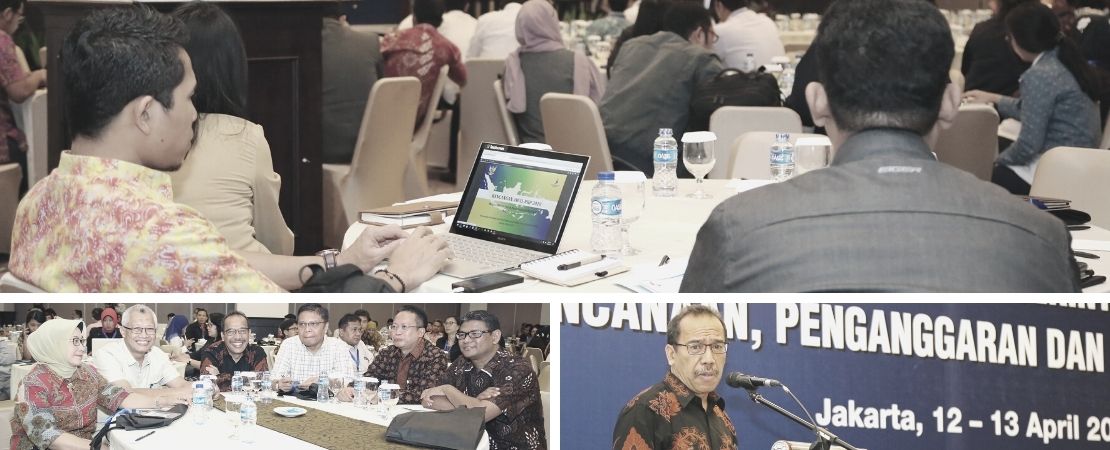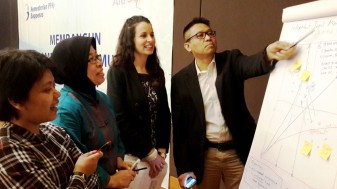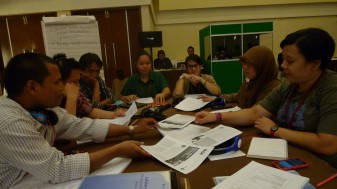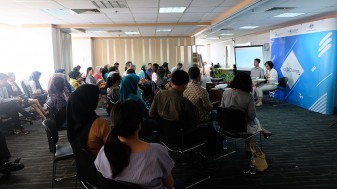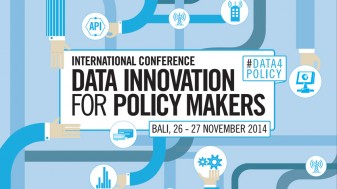In 2016, Bappenas conceived the strategic initiative to begin integrating the various existing development planning platforms. The integration was realized through KRISNA, the Planning and Budget Performance Information Collaborative, a one-stop national planning and budgeting platform, to promote efficiency and effectiveness of national development program implementation.
The annual development planning process in Indonesia has been fragmented for a long time. Ministries and agencies would prepare their plans based on the stipulated National Medium-Term Development Plan (RPJMN). Manually, each ministry and agency would submit their planning to the National Development Planning Ministry/Bappenas to obtain approval and incorporate it into their Annual Work Plan as the basis for passing their budget.
In line with the development of information and communication technology over the last two decades, Bappenas units started to develop electronic systems to facilitate the planning and budgeting process between ministries/agencies. As these initiatives were scattered across agencies at that time, the many platforms and applications were developed in isolation from each other to address their own needs, not integrated as part of a larger ecosystem, and were not designed to be interoperable. An example of this fragmentation of the planning process is irrigation dams built by one ministry that are not informed by the conditions of rice paddies that they will irrigate because that information is managed by another ministry.
To address this gap, in 2016 with the support of the Australian Government through the Knowledge Sector Initiative (KSI), Bappenas initiated a strategy to integrate these disparately formed e-planning systems. This was in line with President Joko Widodo’s message that stressed the importance of integrated development planning in the future.
In 2017, the Planning and Budget Performance Information Collaborative (KRISNA) platform was launched. The first version of KRISNA came with the KRISNA-RENJA application which focuses on collaborative planning and budgeting between ministries/agencies and the central government. This application facilitates ministries/agencies in revising and updating their proposed work plans in an integrated manner. These improvements in the planning process are supported by Government Regulation No. 17 of 2017 concerning Synchronization of National Development Planning and Budgeting, which combines the objectives of Law No. 17 of 2003 concerning State Finance and Law No. 25 of 2004 concerning the National Development Planning System.
The Main Secretary of Bappenas, Himawan Hariyoga Djojokusumo expressed his appreciation for KSI’s role in supporting this process, saying “Since the beginning, when Bappenas felt the need for consolidation so as to create an integrated system, KSI has supported it. This support and cooperation with KSI also contributed to producing Government Regulation No. 17 of 2017”.
Still with KSI’s support, in 2018 KRISNA was further strengthened by the addition of the KRISNA-RKP application for the preparation of Government Work Plans (RKP), and the KRISNA-DAK application as an instrument for preparing infrastructure Special Allocation Fund (DAK) proposals. KRISNA is continuously being improved with additional utilities related to the National Medium Term Development Plan (KRISNA-RPJMN), priority programs, and several additional features. Work plan information from KRISNA serves as a single source of data for the Ministry/Agency Budget and Work Plan (RKAKL) which is prepared through the Agency-Level Financial Application System (SAKTI) platform organized by the Ministry of Finance.
Bappenas Deputy for Development Funding Leonard VH. Tampubolon said that KRISNA’s improvements from 2017 to 2019 were done based on input from users, and from central and local governments alike. Bappenas will continue to assess the reliability of KRISNA, such as how it is able to address the needs of users in ministries/agencies and local governments, as well as in terms of its data security. The latest version of KRISNA that was launched in 2019 featured an integration of systems from other ministries, such as the Ministry of Finance, the Ministry of Administrative/Bureaucratic Reform, and the Ministry of Home Affairs. With KRISNA, inter-ministerial work that was previously more manual is facilitated by a system that makes it more efficient and effective. KRISNA is now used in 87 ministries/agencies, 34 provincial governments, and 514 regency/city governments.
The data in KRISNA is used to plan development and support the integration of work programs between ministries/agencies. According to Erwin Dimas, Bappenas Director of Development Funding Allocation (APP), one clear example of KRISNA data use is the reduction of stunting or malnutrition by several ministries/agencies. KRISNA provides information on work programs carried out in each institution down to project details and locations, including the management of Special Allocation Funds for stunting reduction programs by local governments. “From KRISNA, we can see which stunting programs are not on target and need to be fixed,” said Erwin Dimas.
Another example of the use of KRISNA data that supports integration of programs between ministries/institutions is poverty reduction programs. Vivi Yulaswati, Expert Staff of the Minister of National Development Planning for Social Affairs andPoverty Alleviation, stated that KRISNA succeeded in helping planners map development programs down to component and output levels. The single data in KRISNA prevents redundancies and overlaps between line ministry programs. “With good data, we can evaluate the effectiveness of the implementation of these programs in reducing poverty,” said Vivi Yulaswati. She also said that KRISNA not only managed to integrate programs between line ministries and local governments, but also made them more accountable and transparent. Accountability and transparency of development planning through KRISNA promotes better governance in Indonesia.
The use of KRISNA in support of development planning still has room for expansion. In the short term, KRISNA’s improvements are to strengthen the planning and budgeting process for the 2022 fiscal year. According to Erwin Dimas, KRISNA’s improvements in 2022 are aimed at achieving ‘Three Mores’: more easy, more integrated, and more controllable. More easy, as KRISNA must be able to simplify all planning and budgeting processes in 2022; more integrated, because access for all users and data beneficiaries will be improved; and more controllable, meaning that KRISNA will also be used to monitor priority program planning and implementation processes.
In the long term, KRISNA is expected to be a window for the public to find out the structure of government plans and budgets as a whole. Bappenas’ Director of Industry, Tourism and Creative Economy, Leonardo Adypurnama Alias Teguh Sambodo, stated that in the future, all communities, universities, research institutions, and community groups who want to know the distribution of budgets directed to certain regions, can easily access the information through KRISNA. Additionally, KRISNA will also allow them to actively contribute. As he said, having an open KRISNA can encourage public participation and increase public literacy regarding planning and budgeting policies. KRISNA has proven that it not only succeeded in integrating the long fragmented development planning in Indonesia, but has also paved the way for a more accountable, transparent and participatory governance.

